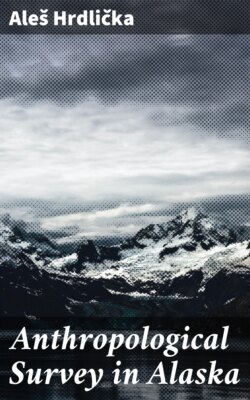Читать книгу Anthropological Survey in Alaska - Aleš Hrdlička - Страница 27
На сайте Литреса книга снята с продажи.
About Nome
ОглавлениеTable of Contents
Due to the delay with the Bear, the next few days until July 23 were spent at and about Nome. They proved more profitable than was expected. Numbers of interesting specimens were found in the possession of some of the dealers, and more of those of scientific value were secured either through gift or by purchase for the National Museum. These collections consisted of objects of stone—i. e., spear points, knives, axes, etc.—but above all of utensils, spear points, effigies, etc., some of them of remarkable artistry and decoration, were made of walrus ivory that through age has turned "fossil."
Among the stone objects were several axes made of the greenish, hard nephrite which came from the "Jade Mountain" on the Kobuk River. The objects from fossil ivory came principally from the St. Lawrence Island, the Diomede Islands, Cape Wales, unknown parts of the nearer Asiatic coast, and here and there from the Seward Peninsula.
A large majority of these objects are now collected by the natives themselves, who assiduously excavate the old sites, and are sold at so much per pound as "fossil ivory" to crews of visiting boats or to merchants at Nome and elsewhere, to be worked up into beads, pendants, and other objects of semi-jewelry that find ready sale among the whites.
In addition a certain part of these objects is reserved by the natives, especially those of the Diomede Islands, and worked up by themselves. The more striking the coloration of the ivory, the more desirable it is for the beads, etc., and the less chance of the object, regardless of its archeological or artistic value, to be preserved. The most artistic pieces, nevertheless, are usually disposed of separately, bringing higher prices than could be obtained for beads.
In this way hundreds of pounds collectively of ancient implements, statuettes, etc., are recovered each year from the old sites on both the Asiatic and the American side of the Bering Sea, and are cut up, their scientific value being lost. Most of the fossil ivory, fortunately, consists of objects which, though showing man's workmanship, are of relatively little scientific value; nevertheless it was seen repeatedly that specimens of real archeological value and artistic interest would be destroyed if their color and texture made them suitable for some of the higher-priced jewelry.
The Eskimo, as repeatedly found later, have not the slightest hesitation about excavating the old sites, and whatever they can not use, which as a rule includes animal and human bones, and in fact everything else except stone tools and ivory, is left in the excavated soil and lost. The amount of destruction thus accomplished by the women, children, and even men each year is large and promises to grow from year to year as long as the supply lasts. This means that unless scientific exploration of these old sites is hastened there will be little left before long to study.
The fossil ivory trade has become such that many of the officers and the crews even of the visiting vessels, including the revenue cutters, engage in buying the ivory from the natives and cutting it up in their spare time into beads and other ornaments. A captain of a well-known boat who with his crew visited in the summer of 1926 a small island on which there is an extensive frozen refuse heap containing many bones and tools of the natives who once occupied the place, exclaimed, "Gad, there's $50,000 of ivory in sight."
The boat crew took away about "2 bushels" of it, or all that could be removed from the extensive frozen pile. I saw some of this ivory later, all cut up, but with a number of the pieces still showing old human handiwork, and some beads made of other parts of the lot were brought later to my office in Washington.
If American archeology and ethnology are to learn what they need in these regions it is absolutely essential that they take early steps for a proper exploration of the old sites, besides which every effort should be made by the intelligent traders, missionaries, teachers, and officials to save the more artistic and characteristic pieces of human workmanship in the old ivory, and bring them with such data as may be available to the attention of scientific men or institutions. It would in fact be of much value, and the writer has suggested this to the Governor of Alaska, to establish a local museum at Nome, where such objects could be gathered and saved to science.
